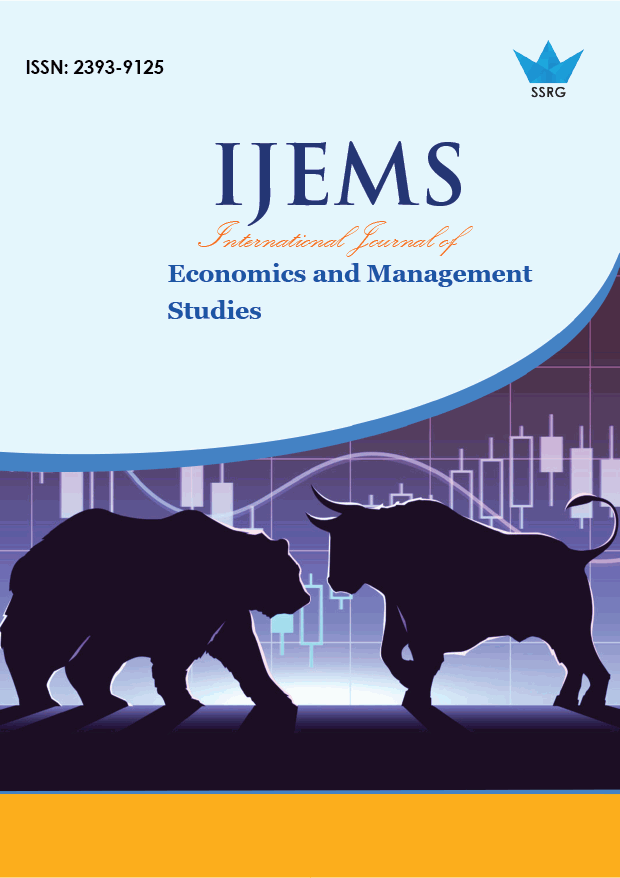Level of Motivations of Technology and Livelihood Education Students of State UniversitiesSamar: Implications to Curriculum Development

| International Journal of Economics and Management Studies |
| © 2019 by SSRG - IJEMS Journal |
| Volume 6 Issue 1 |
| Year of Publication : 2019 |
| Authors : Lilian Engo Aguilana |
How to Cite?
Lilian Engo Aguilana, "Level of Motivations of Technology and Livelihood Education Students of State UniversitiesSamar: Implications to Curriculum Development," SSRG International Journal of Economics and Management Studies, vol. 6, no. 1, pp. ):88-98, 2019. Crossref, https://doi.org/10.14445/23939125/IJEMS-V6I1P109
Abstract:
The study sought to determine the profile of the student respondents in terms of age, sex, family income, type of high school graduated from the course preference; to determine the profile of the teachers in terms of educational qualification, years in teaching Technology and Livelihood Education (TLE) subjects, number of relevant trainings/seminars acquired, and frequency national certifications acquired, and frequency of use of strategies in teaching TLE; to find out the level of motivations of the TLE students; to find out the level of attitude of the students towards TLE; to determine the performance of the students in TLE subjects; to determine whether there is a significant relationship between the profile of the teachers and students’ motivations and attitude towards TLE subjects; to determine there is significant relationship between the motivation and attitude of the students; to determine whether there is a significant relationship between the profile of students and teachers and students’ performance in TLE subjects; to determine whether there is significant relationship between motivations and attitude of the students and performance in TLE subjects; to determine whether there is a significant difference in motivations between student who had TLE as their choice and those who were influenced by other people; and to derive implications of the study to curriculum development. The study was conducted in four state universities in Samar Island offering a Technology and Livelihood Education course. It employed descriptive-
correlational design. Complete enumeration of junior and senior BSEd-TLE, BSIE and BSHE students was employed. Complete enumeration was also done for the teacher respondents. Research instruments on motivations and attitudes were used as data-gathering tools. Secondary data such as the average of grades for the First Semester, SY 2015-2016 was also determined. Statistical tools include frequency counts, means, ranking, multiple regression analysis, and t-test for independent samples. Most of the student respondents were in the 16-17 age range and P20,000–P30,000 income range. Majority of the student respondents were female, graduates of National High Schools, and influenced by other people to take up TLE. Motivations and attitudes were significantly correlated. Age, family income, and type of high school graduated from had no significant relationship with performance while sex, school and course preference had significant relationship with the performance in TLE. However, the teachers’ profile had no significant relationship on the performance in TLE. Motivations and attitudes had no relationship with performance in TLE. Moreover, there was no significant difference in the motivation of students who chose personally TLE as their course and those who were influenced by other people.
Keywords:
Level of motivations, teaching strategies, technology and livelihood education
References:
[1] Albert R. Mann Library. 2014. TLE Archive: Research, Tradition and History (HEARTH). Ithaca, NY: Albert R. Mann Library, Cornell University. http://hearth.library.cornell.edu (Version January 2005).
[2] Alport, G. 1999. Pattern and growth in personality. The American Journal of Psychology, 50, pp. 141-156
[3] Allport, G. 2005. “Attitudes,” in A Handbook of Social Psychology, ed. C. Murchison. Worcester, MA: Clark University Press.
[4] Anyakoha, M.J. 2010. Progress on a cognitive-motivational-relational theory of emotions. American Psychologist, 46(8).
[5] Argyris, C. 2012. Double-loop learning, teaching and research. Academy of Management Learning and Education. 1 (2)
[6] Arribas, L. B. 2012. Philippine Association for TLE in State Colleges and Universities, Inc. Volume 111.
[7] Aseron, D. O. 2004. Effects of external rewards on intrinsic motivation of technology and home economics students in selected secondary schools in metro manila. Unpublished Master’s Thesis. University of the Philippines Diliman, Quezon City.
[8] Azodo, A. P. 2014. Attitude influence on performance in technical skill acquisition among formal technical trainees. International Research Studies in Education 3 (5)
[9] Baharudin, K.L. & Luster, H.W. 2008. Factors related to gender, class type, and academic performance. Journal of Educational Research, 99 (2)
[10] Balagtas, W.B. 2004. Teacher’s personality traits and management skills in relation to academic performance and attitude towards technology and home economics 111 students in division of city schools, las piñas, las piñas city. Unpublished Master’s Thesis.
[11] CHED Memorandum No. 30, s of 2004
[12] Corpuz, R.R. 2009. School motivations and academic engagements of junior and senior TLE students in Batangas State University. Unpublished Master’s Thesis. Polytechnic University of the Philippines, Manila.
[13] Frequently Asked Questions (FAQs) on Assessment and Certification. http://www.tesda.gov.ph/About/TESDA/127
[14] Gardner, R. 2006. The socio-educational model of second language acquisition: a research paradigm. EUROSLA Yearbook, 6.
[15] Gardner, R.C. 1979. Social psychological aspects of second language acquisition. In H. Giles & St. Clair, R. (Eds). Language and social psychology. Oxford: Basil Blackwell.
[16] Gardner, R.C. 1995. Social psychology and second language learning: The role of attitudes and motivation. London: Edward Arnold.
[17] Gardner, R.C. 2011. Integrative motivation and second language acquisition. In Z. Dornyei & R. Schmidt. (Eds.). Motivation and second language acquisition. Honolulu: University of Hawaii.
[18] Kloosterman, A.J. 2006. A New Perspective on Women’s Math achievement, Psychological Bulletin, 105, pp. 198-214. Retrieved through http://www.erc.metu.edu/menu/series04/0417.pdf , January 16, 2014
[19] Ministry of Education. 2005. High Level Summary statements from review of Beacon Schools in TLE and health education: Report to the Ministry of Education.
[20] Ministry of Education. 2006. Draft essence statement for TLE in health and Physical Education Curriculum. Wellington.
[21] Mullis, E.L., Pelletier, L. G., Clement, R. 2010. Perceptions of teachers’ communicative style and students’ intrinsic and extrinsic motivations. The Modern Language Journal. 83 (1)

 10.14445/23939125/IJEMS-V6I1P109
10.14445/23939125/IJEMS-V6I1P109